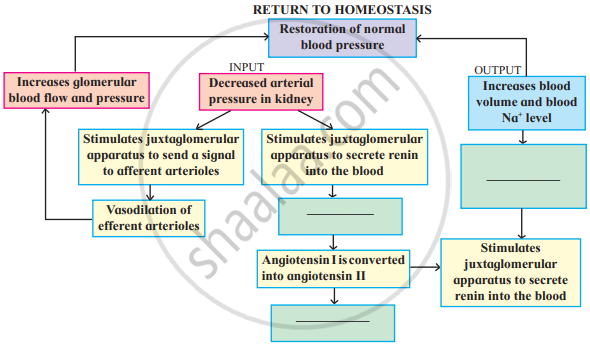Advertisements
Advertisements
प्रश्न
Identify the following structures and explain their significance in renal physiology?
- Juxtaglomerular apparatus
- Podocytes
- Sphincters in the bladder
उत्तर
1) Juxtaglomerular apparatus: It is a specialized tissue in the afferent arteriole of the nephron that consists of macula densa and granular cells.
- Action: The macula densa cells sense distal tubular flow and aspect afferent arteriole diameter.
- Actions of Glandular cells: When there is a fall in glomerular blood flow it can activate Juxta glomerulus cells to release renin from the liver which converts angiotensinogen to angiotensin I.
- Angiotensin converting enzyme converts angiotensin I to angiotensin II.
- It stimulates Na+ reabsorption in the proximal convoluted tubule by vasoconstriction of the blood vessel and increases the glomerular blood pressure.
2) Podocytes:
- The visceral layer of Bowman’s capsule is made of epithelial cells called podocytes.
- The podocytes and the foot processes and the basement membrane of the glomerulus act as a filtering membrane.
- Podocytes act in glomerulus filtration.
3) Sphincters in the bladder:
- The sphincters of the bladder regulate urination.
- When the bladder is full the stretching of the urinary bladder stimulates the CNS through the sensory neurons of the parasympathetic nervous system and brings about contraction of the bladder.
- Somatic motor neurons induce the sphincters to close.
- Smooth muscles contract results in the opening of the internal sphincters and relaxing the external sphincter.
- The sphincter opens and the urine is expelled out.
संबंधित प्रश्न
Urea splitting bacteria are responsible for _______ types of stones.
(A) calcium oxalate
(B) calcium phosphate
(C) calcium carbonate
(D) struvite
Write True (T) or False (F) for the following statement. Rewrite the false statement in the correct form.
Removal of solid undigested food is excretion
What are the two ways by which a person can get relief in case of kidney failure?
How are kidney stones formed?
Draw a diagram of the human excretory system and label the following parts: Kidney, ureter, urinary bladder, and urethra.
Answer the following question.
Doctors say Mr. Shaikh is suffering from urolithiasis. How it could be explained in simple words?
Answer the following question.
John has two options as a treatment for his renal problem: Dialysis or kidney transplants. Which option should he choose? Why?
Complete the diagram/chart with correct labels/ information. Write the conceptual details regarding it.

Ketone bodies are found in the urine of people suffering from ______.
One of the factors which may help to differentiate chronic kidney disease from acute kidney injury is ______
Bright's disease is characterized by the following symptoms EXCEPT ______
Excretion of uric acid includes the following features EXCEPT ______
Ultimate correction for renal failure is:
What is the procedure advised for the correction of extreme renal failure? Give a brief account of it.
Explain, why a haemodialysing unit called artificial kidney?
Which of the following conditions does not lead to acute renal failure?
Which statement is correct regarding the haemodialysis procedure?
Presence of which of the following conditions in urine are indicative of diabetes mellitus?
